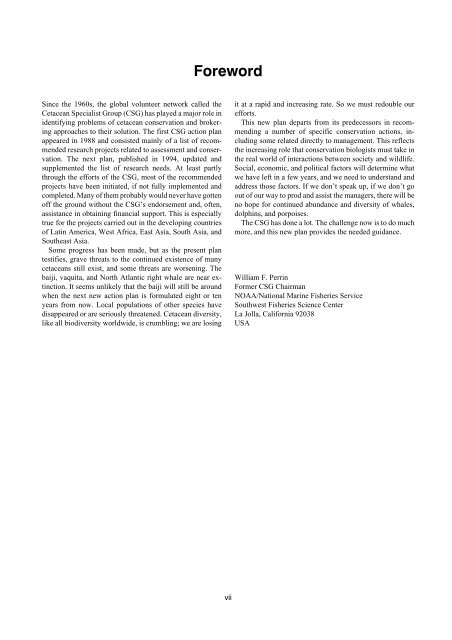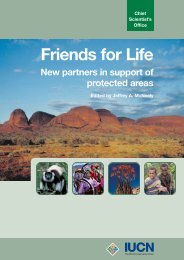Dolphins, Whales and Porpoises: 2002-2010 Conservation - IUCN
Dolphins, Whales and Porpoises: 2002-2010 Conservation - IUCN
Dolphins, Whales and Porpoises: 2002-2010 Conservation - IUCN
You also want an ePaper? Increase the reach of your titles
YUMPU automatically turns print PDFs into web optimized ePapers that Google loves.
Since the 1960s, the global volunteer network called the<br />
Cetacean Specialist Group (CSG) has played a major role in<br />
identifying problems of cetacean conservation <strong>and</strong> brokering<br />
approaches to their solution. The first CSG action plan<br />
appeared in 1988 <strong>and</strong> consisted mainly of a list of recommended<br />
research projects related to assessment <strong>and</strong> conservation.<br />
The next plan, published in 1994, updated <strong>and</strong><br />
supplemented the list of research needs. At least partly<br />
through the efforts of the CSG, most of the recommended<br />
projects have been initiated, if not fully implemented <strong>and</strong><br />
completed. Many of them probably would never have gotten<br />
off the ground without the CSG’s endorsement <strong>and</strong>, often,<br />
assistance in obtaining financial support. This is especially<br />
true for the projects carried out in the developing countries<br />
of Latin America, West Africa, East Asia, South Asia, <strong>and</strong><br />
Southeast Asia.<br />
Some progress has been made, but as the present plan<br />
testifies, grave threats to the continued existence of many<br />
cetaceans still exist, <strong>and</strong> some threats are worsening. The<br />
baiji, vaquita, <strong>and</strong> North Atlantic right whale are near extinction.<br />
It seems unlikely that the baiji will still be around<br />
when the next new action plan is formulated eight or ten<br />
years from now. Local populations of other species have<br />
disappeared or are seriously threatened. Cetacean diversity,<br />
like all biodiversity worldwide, is crumbling; we are losing<br />
Foreword<br />
vii<br />
it at a rapid <strong>and</strong> increasing rate. So we must redouble our<br />
efforts.<br />
This new plan departs from its predecessors in recommending<br />
a number of specific conservation actions, including<br />
some related directly to management. This reflects<br />
the increasing role that conservation biologists must take in<br />
the real world of interactions between society <strong>and</strong> wildlife.<br />
Social, economic, <strong>and</strong> political factors will determine what<br />
we have left in a few years, <strong>and</strong> we need to underst<strong>and</strong> <strong>and</strong><br />
address those factors. If we don’t speak up, if we don’t go<br />
out of our way to prod <strong>and</strong> assist the managers, there will be<br />
no hope for continued abundance <strong>and</strong> diversity of whales,<br />
dolphins, <strong>and</strong> porpoises.<br />
The CSG has done a lot. The challenge now is to do much<br />
more, <strong>and</strong> this new plan provides the needed guidance.<br />
William F. Perrin<br />
Former CSG Chairman<br />
NOAA/National Marine Fisheries Service<br />
Southwest Fisheries Science Center<br />
La Jolla, California 92038<br />
USA






